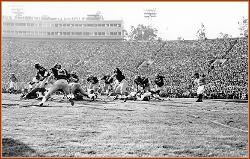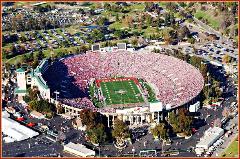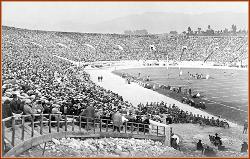



Husky Stadium
Annually voted the most scenic football structure in the nation, Husky Stadium has
proven to be a monstrous opponent for visitors hoping to pin a loss on Washington's
gridiron heroes.
Nestled high above Union Bay in Lake Washington, Husky Stadium has several
characteristics that make it unique among stadiums. A seating capacity of 72,500 allows
Husky Stadium to rank as the nation's 15th largest on-campus facility. It is the largest
stadium, college or professional, in the Pacific Northwest.
With nearly 70 percent of the seats located between the end zones, Husky Stadium can
be one of the loudest stadiums in the nation. During the 1992 Nebraska contest, the first
night game in Husky Stadium history, ESPN sideline crews measured the crowd noise at
130 decibels.
Tailgating takes on a whole new meaning at Husky Stadium. Boat moorings are available
for fans to travel to Washington games via the water. Members of the Husky crew team
shuttle fans back-and-forth between their vessels and the docks adjoining the stadium
grounds. The north upper deck offers sweeping views of Mt. Rainier, the Olympic
Mountain Range and downtown Seattle.
Washington has won 33 of its last 38 games (one tie) in Husky Stadium, including a
school record 17-straight home victories. The Huskies have won 70 percent of their home
games in the stadium, posting an overall record of 298-126-21. Against the Pac-10, the
Huskies have recorded an even more impressive 77-26-2 (.743) record at Husky Stadium.
Built in 1920 at a cost of $600,000, the stadium's initial capacity was listed at 30,000. The
stadium was opened in the dedication game, November 27, 1920, when Dartmouth
defeated Washington, 28-7. A student fund drive, in which students and businessmen
sold plaques at $50 and $100 levels, provided the capital necessary to get the project off
the ground. Two members of the stadium committee were dispatched east to study an
existing report on stadia. Their determination called for a seating capacity of 60,000 and
be constructed in two units. One of the key factors in the layout of the stadium was the
establishment of the longitudinal axis. The goal was to avoid the glare of the sun in the
stadium as much as possible for the benefit of the players.
To accomplish this goal, the astronomical department figured the angle of the rays of the
sun at 4 p.m., November 24, 1920. Based on those measurements, the axis of the
stadium was approximately set at right angles to the rays which established the axis at 71
degrees 50 minutes west of north. The final components in figuring the stadium location
were figuring the best views of the lake and mountains from the interior and working with
the existing confines of the land.
Puget Sound Bridge and Dredging Company was contracted to build the structure. The
original contract to begin construction was signed May 7, 1920 and called for work to be
complete by November 27 for the Dartmouth game a timetable of six months and 20
days. A unique method of excavation know as sluicing, which displaces earth with high
pressure water, was used to clear the area. In all, 230,000 cubic yards of earth was
moved using 687,000,000 gallons of water. The original crown on the playing field
reached a height of 18 inches.
Plans for the stadium called for a four-lane track and the structural drawings called for
stands that would allow patrons to view the entire running track without rising or having
the view obstructed by the person sitting adjacent to him or her. The study resulted in an
elliptical form being adopted.
A sunken passage was built to separate the fans from the field while also providing
drainage for the field and facility. Drainage was a major concern of construction since it
was calculated that one inch of rain fall on the structural portion of the stadium would
accumulate 36,000 gallons of water.
The aisles and seating patterns were planned so that the original capacity crowd of
30,000 could exit the stadium in seven minutes.
The stadium was completed on time despite 46 days of rain during the construction
period. Final work was finished 12 hours before kickoff of the inaugural game.
The stadium experienced further growth in 1936 when 10,000 above-grade seats were
added around the rim of the structure, upping capacity to 40,000.
In 1950, Husky Stadium was again expanded when roof-covered stands were added to
the south side. Approximately 15,000 additional seats, at a cost of $1.7 million, offered
excellent viewing between the goal posts.
A cantilevered steel roof partially covered all seats in the upper deck and approximately
6,000 seats in the lower stands. In the rear of the structure, two silo-shaped ramps
provided access to the upper deck concourses.
The two-level press box and camera deck areas were also installed as part of the 1950
project. The view available for approximately 75 members of the press is 165 feet above
the stadium floor. The south side elevator was also part of the 1950 construction project.
Stadium capacity jumped from 55,000 to more than 59,000 in 1968 when 3,000 seats
were added to the north rim and portable bleachers were installed beyond the east end
zone. AstroTurf replaced the old grass field in 1968, the same year an all-weather track
was installed around the football playing field. Washington was the first major college to
install an AstroTurf field. At the time, the Houston Astrodome was the only other facility to
use the playing surface. Because of the lack of similar fields, the Huskies stocked over
200 pairs of shoes for opponents to use during games. The original artificial turf was
replaced in 1972, 1977, 1987 and, mostly recently, in the summer of 1995.
In 1987, Husky Stadium expanded once again, adding 13,000 new seats. The $13 million
project, performed by Lydig Construction of Spokane, brought the capacity to 72,500.
The hallmark facet of the construction was a glass-enclosed reception area with a field
view from goal line to goal line. Besides serving as an entertainment center on game
days, the Don James Center has the capabilities to host major banquets or social events.
During the summer of 1990, the wooden bleachers in the north upper deck were
replaced with new aluminum seating. The same process was repeated for the south
upper deck in the summer of 1992.
The north deck seats are accessible by ramp or elevator. Husky Stadium possesses
49,580 sideline seats, or 68 percent of total capacity.
In 1989, all major construction in Husky Stadium was concluded with the replacement of
the west stands. The $3.7 million facelift gives Husky fans better seating, more
concession stands and restrooms, a new first aid room, police security area and photo
deck.
In preparation for the 1990 Goodwill Games, Husky Stadium became the beneficiary of a
brand new eight-lane synthetic surface track in the summer of í89. The $1.5 million gift
from the Seattle Organizing Committee provides athletes with a world-class facility. Husky
Stadium hosted the track and field competition and the opening and closing ceremonies
of the 1990 Goodwill Games. What They're Saying About Husky Stadium
"It's always loud, but this game was really loud, especially at crunch time. When they start stomping and
clapping, you can feel the metal rattle in your helmet."
--David Richie, Washington defensive tackle on the 1995 Army game
"70,000 screaming, yelling and stomping--that crowd was probably the biggest difference. The
acoustics here are amazing, a huge factor. I've been around C-130 transports a lot, and this almost felt
like I was on a runway."
--Army defensive tackle Al Roberts
"Washington's ability to attract fans in an urban area speaks to the overall tradition, size, and influence
of the university. Huskies are everywhere. It speaks also to the unique venue and experience that is
Husky Stadium, the stroll down from the hill and through the campus, the mountains melting with the
horizon, the boats, the lake, the rain, the chill, the thrill of old-fashioned football."
--John Owens, Seattle Post-Intelligencer
"I knew it would be a very, very difficult place to play. But I thought it was really a class atmosphere of
Washington and I thought the fans, the administration, it was just a great environment. They were so
rabid for their own team, but with real class. They didn't try to tear you down or anything else, but they
cheered for their team and showed respect for Notre Dame and I think that is a very healthy
environment."
--Notre Dame coach Lou Holtz after the 1995 Irish game at Washington
"The enthusiasm and intensity of the Husky crowd is unreal."
--Brady Brownlee, former Husky kicker.




On February 25, 1987, at 10:09 a.m., a section of the Husky
Stadium on the University of Washington campus, which is
under construction, collapses. It is a 215-foot addition to the
bleachers, which becomes, in about 12 seconds, a 250-ton
pile of twisted steel.
|
The last worker off the structure was painting contractor Ron
Toquinto. He was halfway up the structure when his foreman
said "Hey, come on down … There’s something about this; we
want you all out of here."
Toquinto said, "Just as I was walking out from underneath it …
it started vibrating then violently shaking. It starting unscrewing
itself and folded right to the ground." Again, he stated, "It just
started wobbling and fell down like it was the Narrows Bridge
or something. When I heard it start to go, we ran like hell."
All the workers got away in time. The only possible fatality was
a cat, the ironworkers' mascot. But a few hours later, even the
cat was found in the rubble, alive and apparently unharmed.
|










